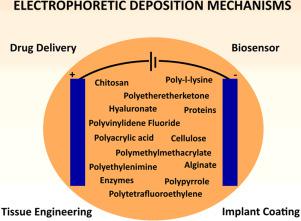Advances in Colloid and Interface Science ( IF 15.9 ) Pub Date : 2020-09-19 , DOI: 10.1016/j.cis.2020.102272 Rebecca Sikkema 1 , Kayla Baker 1 , Igor Zhitomirsky 1

|
This review is focused on new electrophoretic deposition (EPD) mechanisms for deposition biomacromolecules, such as biopolymers, proteins and enzymes. Among the rich literature sources of EPD of biopolymers, proteins and enzymes for biomedical applications we selected papers describing new fundamental deposition mechanisms. Such deposition mechanisms are of critical importance for further development of EPD method and its emerging biomedical applications. Our goal is to emphasize innovative ideas which have enriched colloid and interface science of EPD during recent years. We describe various mechanisms of cathodic and anodic EPD of charged biopolymers. Special attention is focused on in-situ chemical modification of biopolymers and crosslinking techniques. Recent innovations in the development of natural and biocompatible charged surfactants and film forming agents are outlined. Among the important advances in this area are the applications of bile acids and salts for EPD of neutral polymers. Such innovations allowed for the successful EPD of various electrically neutral functional polymers for biomedical applications. Particularly important are biosurfactant-polymer interactions, which facilitate dissolution, dispersion, charging, electrophoretic transport and deposit formation. Recent advances in EPD mechanisms addressed the problem of EPD of proteins and enzymes related to their charge reversal at the electrode surface. Conceptually new methods are described, which are based on the use of biopolymer complexes with metal ions, proteins, enzymes and other biomolecules. This review describes new developments in co-deposition of biomacromolecules and future trends in the development of new EPD mechanisms and strategies for biomedical applications.
中文翻译:

用于生物医学应用的聚合物和蛋白质的电泳沉积
这项审查集中在沉积生物大分子,如生物聚合物,蛋白质和酶的新电泳沉积(EPD)机制。在用于生物医学的生物聚合物,蛋白质和酶的EPD的丰富文献资源中,我们选择了描述新的基本沉积机理的论文。这种沉积机理对于EPD方法的进一步发展及其新兴的生物医学应用至关重要。我们的目标是强调近年来丰富了EPD的胶体和界面科学的创新思想。我们描述了带电生物聚合物的阴极和阳极EPD的各种机制。特别注意的是生物聚合物的原位化学修饰和交联技术。概述了开发天然和生物相容的带电表面活性剂和成膜剂的最新创新。该领域的重要进步之一是胆汁酸和盐在中性聚合物的EPD中的应用。此类创新为生物医学应用成功实现了各种电中性功能聚合物的EPD。特别重要的是生物表面活性剂与聚合物的相互作用,它有助于溶解,分散,带电,电泳迁移和沉积物形成。EPD机制的最新进展解决了与蛋白质和酶在电极表面的电荷逆转有关的EPD问题。在概念上描述了新方法,该方法基于生物聚合物与金属离子,蛋白质,酶和其他生物分子的复合物的使用。











































 京公网安备 11010802027423号
京公网安备 11010802027423号